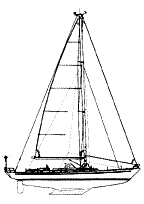Hood 69
Bluewater cruiserr
The hull form is very typical of most Hood designs. The ends are full above the DWL and the overhangs are extensive. This boat salvages 53 feet, 1 inch of waterline out of a 69-foot, 8-inch LOA. That's a total of 15.8 feet of overhangs. The D/L of this design is 259.47. Note the distinct bustle aft, preceding the rudder. There was a time when we believed that the bustle fooled the water into thinking that the boat had a longer waterline. It was also used as a way of increasing the prismatic coefficient on boats with copious midsections.
It does have practical advantages in terms of simply adding depth to the bilge aft, but I'm not sure about its contribution to sailing speed. Clean, smooth runs seem to work better. However, pragmatic considerations aside, by using a bustle configuration, the aft counter can be elevated and the bulk of the stern can be reduced without impacting useable volume in the aft accommodations. I know this is difficult geometry to understand, but trust me, there is a delicate balancing act going on here between aesthetics, interior volume and performance.
The rudder is a large, barn-door-shaped spade-type with about 15 percent balance area forward of the stock centerline. The keel is a low-aspect-ratio fin with outside ballast and a deep centerboard. The keel shape features a flattened bulb with the vulnerable tail lifted just slightly to prevent damage. I will say that it is certainly nice to deal with a design office confident enough and proud enough of their work to send me the complete set of lines.
The interior is laid out for six students forward and two amidships in a small stateroom adjacent to the cockpit, with the master's stateroom aft with a double berth. The galley is located in the passageway. It is very important when you study this rig to realize that it is a development of a rig that has been used over and over by the Hood design office. When you combine one parent hull form with one typical rig this many times, the total package must have reached a stage of advanced evolution. The spreaders are swept aft 22 degrees. This is a lot of sweep. The inner forestay is made of -48 Navtec rod, which indicates to me that it will be in place all the time and is not removable. Removable inner forestays are usually wire so they don't get damaged when being moved. The working jib is about a 120 percent genoa with a very high clew. The SA/D is 16.6. While this may seem low, it is appropriate for a boat of this displacement.
Looking at the sail plan, it's obvious that this will be a beautiful yacht. The gentle, sweeping sheer complements the overhangs. By bringing the backstay inboard, the stern appears to float and is not "held up" by the backstay. The low and trim cabintrunk leaves room for wide side decks and lots of working deck space at both ends of the boat so the crew can dissect clams.
This must be a great school. I can almost hear the discussion at the student council meeting. "I think we should have a 70-foot Hood boat so that we can sail around, study the oceans and have a damn good and stylish time while we are at it."
"All in favor?"

Comments